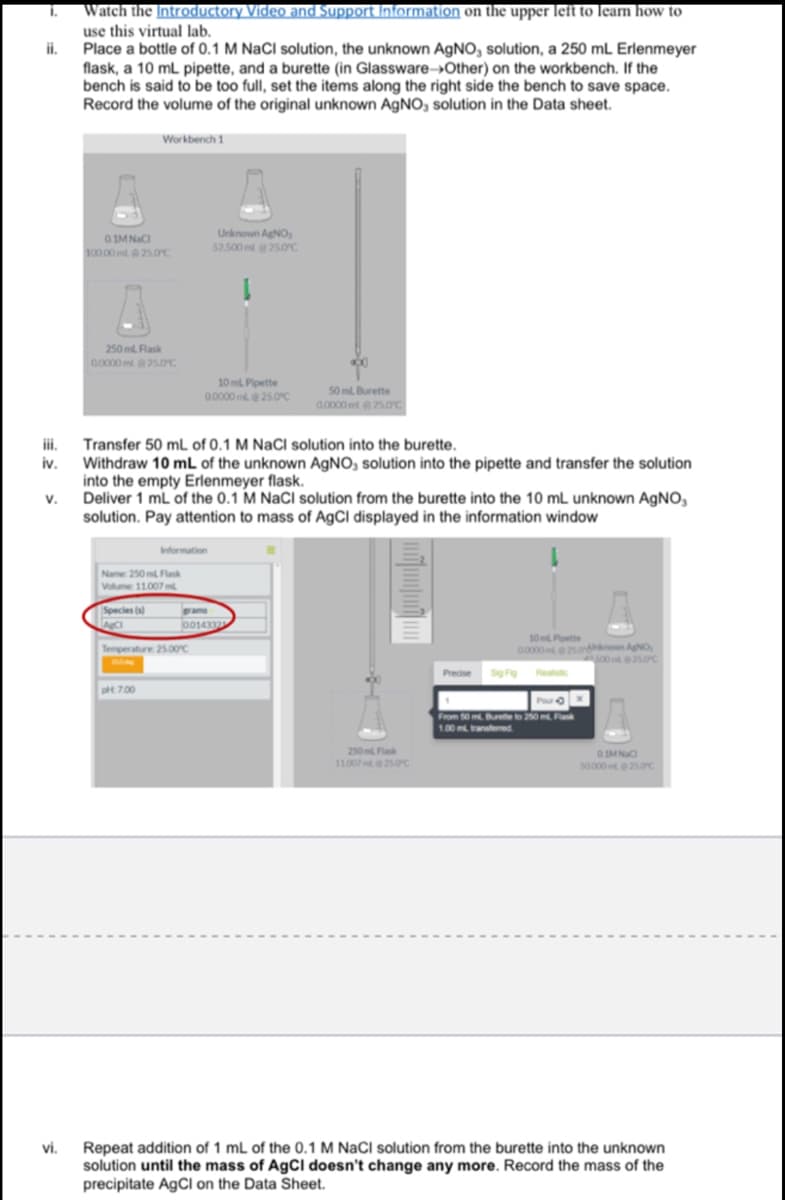Mole of AgCl = (mole = mass /molar mass) %3D Calculate mole of AGNO, in the 10 mL unknown solution based on the following reaction equation: NaClag) + AGNO3(aq) NANO3(ag) + AgCl) (hint, Mole of AGNO, in the 10 mL unknown solution = use the coefficient ratio)
Mole of AgCl = (mole = mass /molar mass) %3D Calculate mole of AGNO, in the 10 mL unknown solution based on the following reaction equation: NaClag) + AGNO3(aq) NANO3(ag) + AgCl) (hint, Mole of AGNO, in the 10 mL unknown solution = use the coefficient ratio)
Chemistry: Principles and Reactions
8th Edition
ISBN:9781305079373
Author:William L. Masterton, Cecile N. Hurley
Publisher:William L. Masterton, Cecile N. Hurley
Chapter3: Mass Relations In Chemistry; Stoichiometry
Section: Chapter Questions
Problem 23QAP
Related questions
Question
Type it out please

Transcribed Image Text:Mole of AgCl =
(mole = mass /molar mass)
Calculate mole of AGNO, in the 10 mL unknown solution based on the following reaction
equation:
NaClag) + AGNO3(aq)
NaNO3(aq) + AgCls)
(hint,
Mole of AgNO3 in the 10 mL unknown solution =
use the coefficient ratio)

Transcribed Image Text:Watch the Introductory Video and Support Information on the upper left to learn how to
use this virtual lab.
i.
i.
Place a bottle of 0.1 M NaCl solution, the unknown AGNO, solution, a 250 mL Erlenmeyer
flask, a 10 mL pipette, and a burette (in Glassware→Other) on the workbench. If the
bench is said to be too full, set the items along the right side the bench to save space.
Record the volume of the original unknown AGNO, solution in the Data sheet.
Workbench 1
Unknown AgNO,
0.IMNaCI
100 00 ml25s.0°C
52.500 ml 25.0c
250 ml Flask
0000 ml25.OC
10 ml Pipette
00000 m 25.0c
50 ml Burette
0.0000 mt250c
ii.
Transfer 50 mL of 0.1 M NaCl solution into the burette.
Withdraw 10 mL of the unknown AGNO, solution into the pipette and transfer the solution
into the empty Erlenmeyer flask.
V.
Deliver 1 mL of the 0.1 M NaCl solution from the burette into the 10 mL unknown AGNO,
solution. Pay attention to mass of AgCl displayed in the information window
Information
Name 250 m Flak
Volume 11007m
Species (s)
ams
001433
10 m Potte
Temperature 25.00c
0000e5oon ANo,
s0025.0C
Predse
t 7.00
From 50 m Bute to o mPa
100 m antened
250m Flask
110075oc
so00025oc
Repeat addition of 1 mL of the 0.1 M NaCl solution from the burette into the unknown
solution until the mass of AgCl doesn't change any more. Record the mass of the
precipitate A9CI on the Data Sheet.
vi.
Expert Solution
This question has been solved!
Explore an expertly crafted, step-by-step solution for a thorough understanding of key concepts.
This is a popular solution!
Trending now
This is a popular solution!
Step by step
Solved in 3 steps

Knowledge Booster
Learn more about
Need a deep-dive on the concept behind this application? Look no further. Learn more about this topic, chemistry and related others by exploring similar questions and additional content below.Recommended textbooks for you

Chemistry: Principles and Reactions
Chemistry
ISBN:
9781305079373
Author:
William L. Masterton, Cecile N. Hurley
Publisher:
Cengage Learning


Chemistry: An Atoms First Approach
Chemistry
ISBN:
9781305079243
Author:
Steven S. Zumdahl, Susan A. Zumdahl
Publisher:
Cengage Learning

Chemistry: Principles and Reactions
Chemistry
ISBN:
9781305079373
Author:
William L. Masterton, Cecile N. Hurley
Publisher:
Cengage Learning


Chemistry: An Atoms First Approach
Chemistry
ISBN:
9781305079243
Author:
Steven S. Zumdahl, Susan A. Zumdahl
Publisher:
Cengage Learning

Chemistry
Chemistry
ISBN:
9781305957404
Author:
Steven S. Zumdahl, Susan A. Zumdahl, Donald J. DeCoste
Publisher:
Cengage Learning

Introductory Chemistry: A Foundation
Chemistry
ISBN:
9781285199030
Author:
Steven S. Zumdahl, Donald J. DeCoste
Publisher:
Cengage Learning

Chemistry & Chemical Reactivity
Chemistry
ISBN:
9781337399074
Author:
John C. Kotz, Paul M. Treichel, John Townsend, David Treichel
Publisher:
Cengage Learning